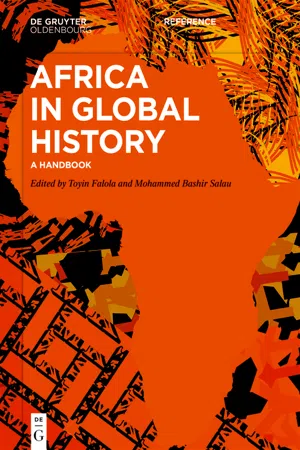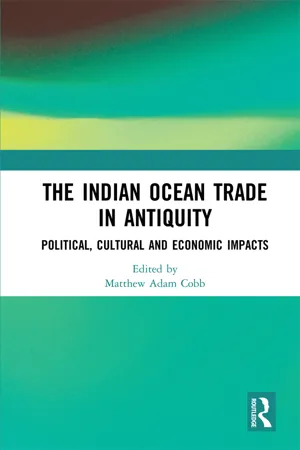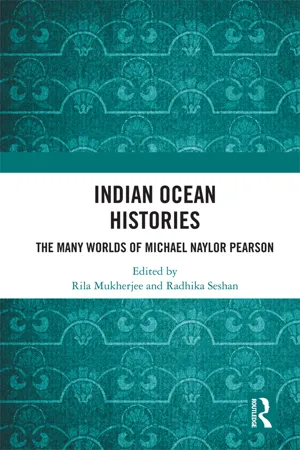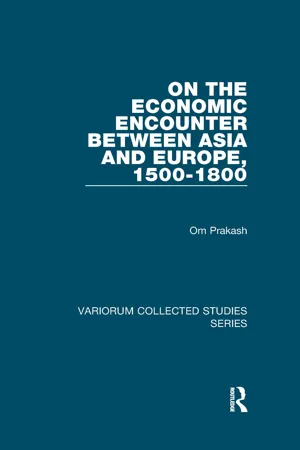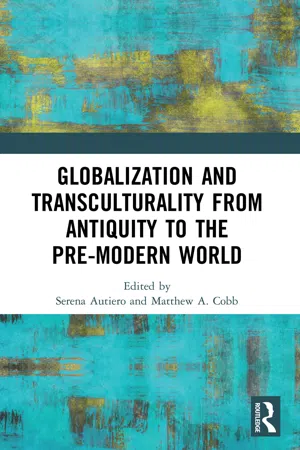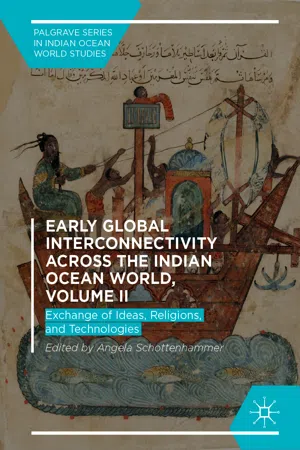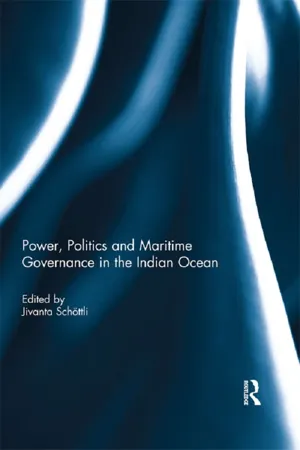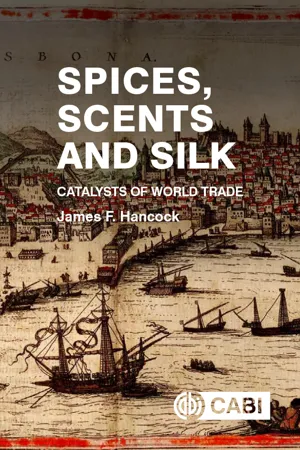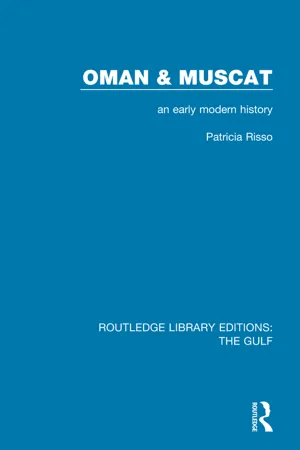History
Indian Ocean Trade
Indian Ocean Trade refers to the exchange of goods and ideas between the countries bordering the Indian Ocean from ancient times to the present day. This trade network facilitated the exchange of spices, textiles, precious metals, and other commodities, as well as the spread of religions and cultures across the region. The Indian Ocean Trade played a significant role in shaping the economies and societies of the countries involved.
Written by Perlego with AI-assistance
Related key terms
Related key terms
1 of 4
Related key terms
1 of 3
10 Key excerpts on "Indian Ocean Trade"
- eBook - ePub
Africa in Global History
A Handbook
- Toyin Falola, Mohammed Bashir Salau(Authors)
- 2021(Publication Date)
- De Gruyter Oldenbourg(Publisher)
Africa has always been integral to the worlds of the Indian Ocean. Although the intensity of its connections to this broader oceanic space have varied across time and chartered different social and cultural geographies as delineated by the movements of people, things, ideas, texts and even legal idioms that have travelled between coasts and interiors, Africa and Africans have been indispensable in shaping its many histories. Caravan and trade routes linked interior exchange with coastal mercantile interests and, in turn, to the broader transoceanic shipping routes that together shaped the contours of the Indian Ocean as a space of multilayered interactivity over many centuries. The African continent’s connections to and intercourse with the Indian Ocean, therefore, spanned vast distances of braided terrestrial and maritime linkages that assumed varying degrees of importance for commercial activity over short, medium, and long distances.Yet African connectivity to the Indian Ocean was not defined only by the economic realm or mercantile interests, as important as these were to the establishment and maintenance of relationships between different parts of the continent and the further reaches of the ocean. Rather, the ties that bound Africa to the Indian Ocean world were various and involved a variety of actors, from the botanical and food exchanges that brought bananas, yams, and other comestible items to the continent; and the Arab and Muslim travelers in the ninth and tenth centuries who sailed from southern Arabia to Mogadishu, Kilwa, and elsewhere; to the musical influences that have spread from the continent to offshore islands such as the Comoros and Reunion and are maintained by particular diasporic formations; as well as African sailors who laboured on coastal and transoceanic vessels as they chartered maritime itineraries of varying length and complexity. These wide-ranging experiences and movements reflect the myriad ways in which Africans both engaged with and shaped the historical currents of the Indian Ocean, creating vital sinews of connection that were constitutive of the ocean’s mutable social geographies.This chapter describes key aspects of the historical relationship between Africa and the broader Indian Ocean world over two millennia of complex and multilayered commercial, social, religious and cultural intercourse. While it will identify the processes that structured the far-flung interactions between Africans and the furthest reaches of the ocean, its focus of necessity will be on the western Indian Ocean where these interactions were most pronounced and enduring, and where Africans established dynamic and sophisticated connections with the Red Sea, the Gulf, and South Asia, forging wide-ranging connections with the worlds around them and helping to shape them in fundamental ways. - eBook - ePub
The Indian Ocean Trade in Antiquity
Political, Cultural and Economic Impacts
- Matthew Adam Cobb(Author)
- 2018(Publication Date)
- Routledge(Publisher)
1 IntroductionThe Indian Ocean in Antiquity and global history
Matthew Adam CobbIntroduction
Through a series of contributions from ten scholars, this book examines the impact of the Indian Ocean Trade on various societies in the age of Antiquity – delimited in this volume from 300 BCE to 700 CE . This includes an analysis of the development of networks of exchange, nodal points and cross-cultural interactions, as well as an investigation of the wider political, cultural and economic effects of the consequent movement of goods, peoples and ideas. Emerging from a research panel held at Dublin 22–25 June 2016, this book aims to facilitate interdisciplinary exchanges among scholars working in a range of fields (Classics, South Asian Studies, Near Eastern Studies) and who utilise various methodological approaches (textual and historical analysis, archaeology, art history, among others). The desired outcome of this collaboration is for these essays to provide fresh perspectives for scholars interested in the Indian Ocean, but who are used to working in the traditional silos of their discipline.1 In order to more fully appreciate the various interconnections of the Indian Ocean in Antiquity, and its wider cultural impacts, researchers must be willing to work collaboratively. Even the most industrious polymath could not hope to master every conceivable field of study or every item of evidence that might be applicable.We feel that this book is timely in light of the increasing volume of new archaeological and written evidence that is being unearthed at various international sites. In south-western India, ongoing excavations at Pattanam (probably ancient Muziris) have revealed a whole range of material showing trade links with regions such as the Mediterranean, western Asia and China.2 In East Africa, the site of ancient Adulis has been subject to recent Eritro-British and Eritro-Italian excavations, while a range relevant of material has also be discovered in recent decades at the southern Arabian sites of Qana’ or Qāni (near modern Bir ‘Alī, Yemen) and Sumhuram (modern Khor Rori, Oman).3 - eBook - ePub
Indian Ocean Histories
The Many Worlds of Michael Naylor Pearson
- Rila Mukherjee, Radhika Seshan(Authors)
- 2019(Publication Date)
- Routledge India(Publisher)
The era of the Medieval Warm Period (as it was labelled in northwest Europe) is known to have brought a warm and humid climate to most regions of the world from 900 to 1250 CE. It therefore brought ample harvests and growing population to the Indian Ocean region. From 1250, temperatures stabilised and then declined from 1350 for some four hundred years before beginning to rise. During the period to 1500, the Indian Ocean region experienced relative peace and prosperity.Within the confines of the Indian Ocean, the ancient commercial system continued to mature. Ships from three traditions crossed the seas, trans-shipped goods in harbours and underwent repair in home ports and distant workshops. The dhows of the Western and Eastern Indian Ocean, the proas of the Malay mariners and the junks from China, each type built at varying scales, maintained their original designs yet adopted innovations from each other. The principal ports changed, over the centuries, though the regions served by shifting ports changed little. An overlapping set of languages was employed in commerce, varying across the regions and over time.Regions, ethnicities and religions served as markers of culture and identity: the ancient settlement of the region meant that there was deep cultural diversity in the Indian Ocean region, but it also meant that devices had been developed for exchange and communication across the persistent cultural divides (Pearson 1994).2 In the era from 1200 to 1500, migrations were relatively small scale and took the form of trade diasporas or missionary diasporas. Trade diasporas included those of Armenian and Gujarati merchants; religious diasporas included those of Islamic missionaries to East Africa and the Malay lands and Buddhist missionaries from Ceylon to Thailand and Burma.Commerce of the Indian Ocean extended in various directions beyond the limits of the tropical semicircle. From the Western Indian Ocean, exchange had long taken place along the East African coast; with the Mediterranean, through the Red Sea; with West Asia, through the Persian Gulf and the Tigris-Euphrates Valley; and with Central Asia, through the Khyber Pass. From the Eastern Indian Ocean, the valleys of the Ganges, the Brahmaputra and the Irrawaddy led to southwest China, while the Strait of Malacca and the Strait of Sunda led to the Spice Islands and the South China Sea (Pearson 2010b).3 - Om Prakash(Author)
- 2023(Publication Date)
- Routledge(Publisher)
II India in the Indian Ocean Trading Network on the Eve of the Europeans' Arrival in the Asian Seas DOI: 10.4324/9781003420750-2Among the historic consequences of the discovery by the Portuguese at the end of the 15th century of the all-water route to the East Indies via the Cape of Good Hope was the overcoming of the transport technology barrier to the growth of trade between Asia and Europe. The volume of this trade was no longer subject to the capacity constraint imposed by the availability of pack animals and river boats in the Middle East. Also, it was only after the discovery of the Cape route that the procurement of Asian goods as well as their transportation to Europe was organised by the Europeans themselves, who had travelled to the East in any number for the first time. What kind of trading network did the Portuguese find in operation on their arrival in the Indian Ocean? This paper analyses the central elements of this network from the vantage point of India, which was at the centre of the Portuguese - and later of the other Europeans’ trading activities in Asia,An analysis of the structure and the mechanics of the early modem Indian Ocean Trade, alternatively referred to as Asian trade, ought perhaps to start with a recognition of the simple fact that this trade transgressed the boundaries of both the Indian Ocean as well as those of Asia. While in the east, it intruded prominently into the South China Sea, in the west, it embraced maritime trade with East Africa. Traditionally, the great arc of Asian trade included the Persian Gulf and the Red Sea in the northwest. The principal natural divisions of this huge area were the Arabian Sea, the Bay of Bengal and the South China Sea. Within each of these zones, there were important blocks of ports across which a large amount of trade had traditionally been carried on. The western or the Arabian Sea zone included ports in the Persian Gulf, the Red Sea, those on the East African coast and on the west coast of India. The Bay of Bengal network included ports in Sri Lanka, the Coromandel coast, Bengal, Burma, Thailand, Malaya and Acheh in Sumatra. Ports such as Canton and Zaiton in the South China Sea had extensive contacts both with the Indonesian ports as well as with ports in the straits of Malacca. Within each of these zones, there were also clearly identifiable sub-zones. To take an example, in the west, the ports of Aden, Hormuz, Cambay and Calicut formed one such sub-zone, while those of Kilwa, Mogadishu, Aden and Jiddah constituted another. Needless to emphasise, in terms of the ability of different constituents of a given zone to put important tradeable goods on the market, for which there was adequate demand elsewhere in the zone, there was a very definitive basis for trade within each of the zones. Such a basis also existed to an important degree across zones leading to the creation of significant long-distance trade flows in the Indian Ocean and beyond. By far the longest distance was covered by the route that connected Aden to Canton traversing a very large part of the total area covered by the great arc of Asian trade. There is evidence to suggest that this route was in regular use at least from the 7th century on. The principal group which had initiated trade on the route was the Persian merchants who had, however, been supplanted by and large by Arab merchants since about the 9th century on. The principal stops on the way were either Cambay or Calicut on the Indian west coast and a port such as Palembang in Sumatra. It would seem that sometime during the 12th century, Chinese junks also began operating on this route. There is evidence that the Chinese merchants established commercial contacts with places such as Sri Lanka, Quilon on the Malabar coast and with Hormuz in the Persian Gulf. The Chinese participation in trade on this route would appear to have reached important levels by the early years of the 15th- Serena Autiero, Matthew Adam Cobb(Authors)
- 2021(Publication Date)
- Routledge(Publisher)
Ancient West and East 7: 67–79.- Shahar , Yuval. 2004: Josephus Geographicus: The Classical Context of Geography in Josephus . Tübingen: Mohr Siebeck.
- Sidebotham , Steven. E. 1986: Roman Economic Policy in the Erythra Thalassa: 30 BC–AD 217 . Brill.
- Sidebotham , Steven. E. 2011: Berenike and the Ancient Maritime Spice Route . Oakland: University of California Press.
- Sidebotham, Steven. E. and Iwona Zych. 2012: ‘Results of fieldwork at Berenike: a Ptolemaic Roman port on the Red Sea coast of Egypt, 2008–2010’, Topoi Supplement 11: 133–157.
- Singer , Caroline. 2007: ‘The Incense Kingdoms of Yemen: An Outline History of the South Arabian Incense Trade’, in Peacock and Williams 2007: 25–57.
- Sommer , Michael. 2015: ‘OIKOYMENH. Longue durée perspectives on ancient Mediterranean “globality”’, in Pitts and Versluys 2015b: 175–197.
- Tomber , Roberta. 2013: ‘Hadrian and Egypt: Exchange and Embassies in 2nd – Century AD Trade with the East,’ in Opper 2013: 112–119.
- Versluys , Miguel. J. 2014: ‘Understanding objects in motion. An archaeological dialogue on Romanization’, Archaeological Dialogues 21(1): 1–20.
- Warmington , Herbert. E. 1928: The Commerce Between the Roman Empire and India . Cambridge: Cambridge University Press.
- Wheeler , Mortimer. 1955: Rome Beyond the Imperial Frontiers . London: Penguin Books.
- Wilson, Andrew and Bowman, Alan. 2017: ‘Introduction’, in Wilson and Bowman 2017: 1–26.
- Wilson , Andrew and Alan Bowman (eds.), 2017: Trade, Commerce and the State in the Roman World . Oxford: Oxford University Press.
Passage contains an image
Matthew A. Cobb8 Mediterranean goods in an Indian context
The use of transcultural theory for the study of the ancient Indian Ocean world *
DOI: 10.4324/9781003096269-12Introduction
The recent growth of interest in trade and interconnectivity across the ancient Afro-Eurasian world (c . 300 BCE – 700 CE) has been spurred on by a number of factors. One of these is evidential: new archaeological discoveries have been made at a range of sites across the globe, while more epigraphic, papyrological and numismatic studies have also been undertaken.1 A second major factor is the development of scholarly interest in global history and the history of globalization, which are both concerned with how things, people and ideas circulated, as well as how individuals and groups within different societies responded to these movements and exchanges (including socio-economic, political and cultural responses).2- eBook - ePub
Early Global Interconnectivity across the Indian Ocean World, Volume II
Exchange of Ideas, Religions, and Technologies
- Angela Schottenhammer(Author)
- 2019(Publication Date)
- Palgrave Macmillan(Publisher)
A Companion to the Archaeology of the Ancient near East (Malden: Blackwell), 1041–1059; for a recent synthesis.22Erich S. Gruen (2002) Diaspora: Jews Amidst Greeks and Romans (Cambridge, MA: Harvard University Press), 54–83.23Jacob Neusner (1965–1970) A History of the Jews in Babylonia , 4 vols (Leiden: E. J. Brill).24Glen W. Bowersock (2013) Throne of Adulis: Red Sea Wars on the Eve of Islam (Oxford: Oxford University Press); Joëlle Beaucamp, Françoise Briquel-Chatonnet and Christian J. Robin (2010) Juifs et chrétiens en Arabie aux Ve et Vie siècles: regards croisés sur les sources (Paris: ACHCByz); and Christian Julien Robin (1980) “Judaïsme et christianisme en Arabie du sud d’après les sources épigraphiques et archéologiques”, Proceedings of the Seminar for Arabian Studies 10, 85–96.25Alexander V. Sedov (2010) “Les Fouilles De Secteur 3: La Synagogue”, in Jean-François Salles and Alexander V. Sedov (eds.), Qani: Le Port Antique Du Hadramawt Entre La Méditerranée, L’afrique Et L’inde Fouilles Russes 1972, 1985 –1989, 1991, 1993 –1994 (Turnhaut: Brepols), 87–122.26See Nathan Katz and Ellen S. Goldberg (1993) The Last Jews of Cochin: Jewish Identity in Hindu India (Columbia: University of South Carolina Press).27Eusebius [263–229] (2005) Ecclesiastical History , ed. Roy J. Deferrari, vols. 1–5 (Washington: Catholic University of America Press).28Rodney Stark (2012) The Triumph of Christianity , 71–80.29Eric G. Turner (1954) “Tiberivs Ivlivs Alexander”, The Journal of Roman Studies , 44, 54–64.30Steven E. Sidebotham (1986) Roman Economic Policy in the Erythra Thalassa: 30 B.C. –A.D.217 [Mnemosyne, 91] (Leiden: E. J. Brill), 84–85; Kai Ruffing (2013) “The Trade with India and the Problem of Agency in the Economy of the Roman Empire”, in Silvia Bussi (ed.), Egitto. Dai Faraoni agli Arabi - Jivanta Schoettli(Author)
- 2016(Publication Date)
- Routledge(Publisher)
https://www.cia.gov/library/publications/the-world-factbook ). Moreover, the protracted character of such disagreements has the potential to undermine cooperative frameworks necessary to combat challenges in the region.Energy, trade, and resources in the IOR Energy and tradeThe Indian Ocean is at the crossroads of global commerce and energy flows. With 61% of total global container traffic and 70% of traffic in petroleum products transiting through this route, the security of waterways and chokepoints in the IOR are of critical global significance. Of the total trade traffic traversing the Indian Ocean, roughly 20% is destined for the littorals and 80% of sea borne trade is extra-regional, thus indicating the impact that a deterioration in security environment of the region resulting from disruption of the SLOCs could have on the global economy. The trade routes of greatest regional concern are those taken by oil and gas flows from the Persian Gulf to the east and the flows of manufactured goods from Asia to the west. Energy projections for the time period under study further emphasise the strategic economic value of the Indian Ocean: China’s energy deficiency across all fuels is set to aggravate by almost five times and India’s by almost twice (chiefly in oil and coal) from 2011 through 2030, thus driving up the current scale of sea-based imports (Carr & Nguyen, 2012). This highlights the significance of India and China’s ‘Hormuz dilemma’, or the critical dependence of their economic growth on unhindered flow of imports passing through the Strait of Hormuz. In China’s case, this is further topped up by the ‘Malacca dilemma’, or its dependence on imports through the Malacca Strait. Though several pipeline projects aim to reroute oil exports to avoid the strategically sensitive chokepoints in the region are expected to kick-off in the coming decades,7- eBook - ePub
Spices, Scents and Silk
Catalysts of World Trade
- James Hancock(Author)
- 2021(Publication Date)
- CAB International(Publisher)
6 Origins of the Spice Trade in the Indian Ocean Setting the Stage – Central Role of RiversThe ancient civilizations of Egypt, Mesopotamia and Harappa all evolved along mighty rivers that provided rich alluvial soils, irrigation waters and transportation. The Tigris and Euphrates Rivers were the backbone of ancient Sumer and the Mesopotamian kingdoms that followed. The ancient Harappa civilization relied on the Indus River. The Nile served as the lifeblood of the Egyptian kingdoms. These rivers fed the agricultural productivity of these great states and served as a vehicle to move grain, ores, stone and luxury products.Ultimately, these great societies became connected by their seafarers following their rivers through linking seas and gulfs to the Indian Ocean. Once linked, they became united through maritime trade. This trade was driven by the human desire for the exotic – manufactured goods, precious stones, metal ores, unusual animals and spices. In particular, the spices cinnamon, ginger and pepper came to generate the lion’s share of profits to the merchants willing to tackle the treacherous sea journeys. The movement of these spices came to be known as the ‘Spice Route’ and eventually spanned 15,000 kilometres (9300 miles) from the west coast of Japan, through the islands of Indonesia, around India to the Middle East and across the Mediterranean to Europe.Persian Gulf RoutesWater transport down the Tigris and Euphrates was likely born about 6000 years ago to transfer copper from the Ergani mines in Anatolia to the southern Sumerian settlements around Uruk in southern Iraq. Travel down the turbulent rivers would have been rapid with prevailing north to south winds; upstream travel would have been very difficult. The earliest vessels of the Mesopotamians were made of reeds or skins to prevent their hitting the bottoms of shallows (Paine, 2013 - eBook - ePub
A History of Southeast Asia
Critical Crossroads
- Anthony Reid(Author)
- 2015(Publication Date)
- Wiley-Blackwell(Publisher)
[3]Trade and Its NetworksThe first two chapters of this book would have made little sense without reference to trade connections around the tropical seas. The presence of Chinese ceramics, Dongson (Red River valley) bronzes and Indian statues in seemingly remote corners of Southeast Asia from the beginning of the Common Era shows that long-distance trade affected them vitally for centuries before we have historical records. Nevertheless, the growing importance and measurability of trade in the age of commerce after 1400 makes this the point for a more systematic discussion of how it operated. The horizontal bonds of trust formed by different trading networks served both to integrate the civilizational patterns built by religion and written language and to link them with the broader worlds of Eurasia.Land and Sea Routes
The commercial symbiosis of upstream agricultural centers and downstream ports appears to have been a feature of the river systems of the region for at least two millennia. As a missionary described the pre-Spanish Philippines:The inhabitants of the mountains cannot live without the fish, salt, and other articles of food … of other districts; nor, on the other hand, can those of the coast live without the rice and cotton of the mountaineers (Loarca 1582, 121).The trade centers near river-mouths or other strategic waterways could usually not provide themselves with rice. This was shipped down to them on the rivers from the more fertile and productive uplands. In return, however, all upland populations had need of salt, produced in tidal ponds for the most part. In exchange for their rice and other agricultural products, they also received dried fish from the downstream centers, and a variety of imported goods – precious metalware, ceramics, and cloth in particular, often produced as far away as India and China. - eBook - ePub
Oman and Muscat
An Early Modern History
- Patricia Risso(Author)
- 2016(Publication Date)
- Routledge(Publisher)
Chapter 5 Trade in the Persian/Arabian Gulf and Indian Ocean During the Imâmate of Aḩmad B. Saʿîd (1749-1783)DOI: 10.4324/9781315645353-5There are no systematic records of indigenous maritime commerce, and there are several obstacles to isolating ʿUmânî trade in particular. Indigenous merchants, as well as those Europeans engaged in 'local' trade1 carried various commodities which were available at entrepots as well as ports of origin. It is difficult or often impossible to determine the owners of a ship or its cargo. The tonnage of vessels and breakdown of cargoes were seldom recorded. Ships' captains could hoist flags other than their own, either to claim legitimate protection or, as a disguise, to avoid harassment or seizure. There is an additional problem in that European reports often lumped ʿUmânî trade with that of Başra or of the whole Gulf. The British did not realize the extent of Masqaţ's trade until the 1790s; but as it threatened British private rather than Company trade, even then the records and reports remained inadequate. For all these reasons, it is possible only to trace the basic pattern of the ʿUmânî carrying trade and to extrapolate from the few existing figures the amounts and values involved. Even so, a good deal can be said.It is necessary first to give an overview of commercial changes in this period, changes which, it will be shown later, were to ʿUmân's advantage. In the 1740s, the east coast of India still traded primarily with the west coast, at Surat, Bombay and Malabar ports, and there was also a lucrative trade with the Gulf. 2 The Dutch and English had become the most important European powers in the area. The decline in political power of the Muslim Şafavîs and Mughals had its commercial counterpart. In the early 1730s, Surat underwent a breakdown in government and trade from which it never fully recovered.3 Insecurity of both investments and property led to migration, particularly to Bombay, which came to replace Surat in commercial importance and was the seat of a British Presidency.4 As Mughal power declined, so did the privileged position of Muslim merchants, who had been in indirect competition with the Europeans.5
Index pages curate the most relevant extracts from our library of academic textbooks. They’ve been created using an in-house natural language model (NLM), each adding context and meaning to key research topics.
Explore more topic indexes
Explore more topic indexes
1 of 6
Explore more topic indexes
1 of 4
